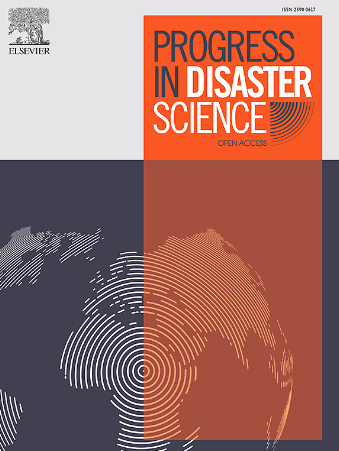Multiple hazards and population change in Japan’s Suzu City after the 2024 Noto Peninsula Earthquake
IF 3.8
Q3 ENVIRONMENTAL SCIENCES
引用次数: 0
Abstract
The earthquake that struck Japan’s Noto Peninsula on January 1, 2024, caused extensive damage, leading to the first major tsunami warning since the 2011 Tohoku earthquake. It remains unclear where people moved immediately after the earthquake and how earthquake-induced multiple hazards affected human mobility, reflecting evacuation movement. This study examines the human mobility change in Suzu City, severely damaged by strong ground shaking and multiple hazards, including tsunamis and liquefaction, from January 1 to January 3, 2024, using population estimates based on cell phone networks. Specifically, we unravel the detailed spatiotemporal changes in population distribution in the affected areas, reflecting evacuation from the tsunami and other multiple hazard factors. Our results reveal that immediately after the earthquake, people concentrated in inland areas, suggesting that the major tsunami warning facilitated the evacuation from the coast to inland areas. Furthermore, the sense of strong ground shaking and tsunami inundation risk may have triggered tsunami evacuation. A clear drop in population was delayed by one to two days after the earthquake in areas with a high liquefaction potential and landslide occurrence. This study’s outcomes contribute to a better understanding of human mobility during disasters, thereby aiding future disaster-management decisions.
2024年诺东半岛地震后日本宿州市的多重灾害和人口变化
2024年1月1日发生在日本诺户半岛的地震造成了广泛的破坏,导致了自2011年东北地震以来的第一次大海啸预警。目前尚不清楚地震后人们立即转移到哪里,以及地震引发的多重灾害如何影响人们的流动性,反映了疏散活动。本研究利用基于手机网络的人口估计,研究了2024年1月1日至3日,受到强烈地面震动和海啸、液化等多种灾害严重破坏的宿州市的人口流动变化。具体来说,我们揭示了受灾地区人口分布的详细时空变化,反映了海啸和其他多重灾害因素的疏散。我们的研究结果显示,地震发生后,人们立即集中在内陆地区,这表明大海啸预警促进了从沿海地区向内陆地区的疏散。此外,强烈的地面震动感和海啸淹没风险可能引发海啸疏散。在高液化潜力和发生滑坡的地区,人口的明显下降要在地震后一到两天才会出现。本研究的结果有助于更好地了解灾害期间的人员流动性,从而有助于未来的灾害管理决策。
本文章由计算机程序翻译,如有差异,请以英文原文为准。
求助全文
约1分钟内获得全文
求助全文
来源期刊

Progress in Disaster Science
Social Sciences-Safety Research
CiteScore
14.60
自引率
3.20%
发文量
51
审稿时长
12 weeks
期刊介绍:
Progress in Disaster Science is a Gold Open Access journal focusing on integrating research and policy in disaster research, and publishes original research papers and invited viewpoint articles on disaster risk reduction; response; emergency management and recovery.
A key part of the Journal's Publication output will see key experts invited to assess and comment on the current trends in disaster research, as well as highlight key papers.
 求助内容:
求助内容: 应助结果提醒方式:
应助结果提醒方式:


